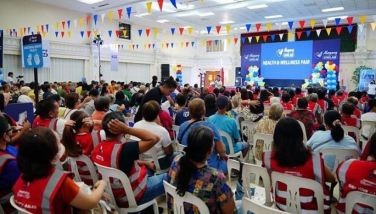When art beckoned Bea Zobel Jr.
October 29, 2003 | 12:00am
‘Art is not just for the elite, it’s not just about a painting that’s sold at Christie’s for an exorbitant amount. Everything around us is art – even the silly and the trivial.’
Bea Zobel Jr. is fidgety. Decked out in a black and green terno on the foyer of her mother’s house, she insists on not knowing what to do despite an entire team of acolytes shouting out instructions on how she should pose for the camera. Pepito Albert, dear friend and creator of the said terno, tells her to loosen her shoulders – and to smile. Bea obliges, reluctantly. The sigh of relief is more than audible as soon as the camera is off her. "I have never been comfortable being in front of the camera," she declares.
It’s ironic that what’s causing Bea so much discomfort this time around is one of her life passions. Bea Zobel, Jr’s love for the arts has brought her to this pictorial, her nth in a span of three weeks. It’s her contribution as presidential daughter Luli Macapagal Arroyo’s co-chair for the Metropolitan Museum’s major fund-raising project for the year, one that focuses on the beauty and elegance of the Philippine terno. For the past three weeks, Bea has been enthusiastically trying to promote her project by consenting to appear in pictorials wearing the terno, an ensemble that she has learned to appreciate more. Since the terno project has begun, Bea Jr. has had six ternos made, all by Pepito Albert. "I have more ternos than underwear," she reveals, in a manner so candid that it throws off the intimidating façade that first greets you upon first glance.
More of the candidness is revealed as Bea begins to talk lengthily of her new project and how it started out. Without the camera pointed at her, Bea is as flexible as she is surprisingly unintimidating. Along with Ino Manalo, the Met’s curator and the individual credited for introducing Bea to the beauty and immense possibilities of Philippine art, Bea effusively expounds on the dissoluble, yet often unrecognized, relationship between art and development.
"The message the Met is trying to get through is that art is what we need for the development of our country. Art provides livelihood, provides jobs, it gives identity." This time the museum chose to showcase a form of art that is more familiar and more significant to Filipinos all over the country. Says Ino Manalo, "We thought of showcasing this broader, more popular, more democratic form of art, one that’s often overlooked because it’s simply shown as costume, or clothing but it’s actually an artform – the terno."
More than the baro’t saya or any other traditional Philippine costume, the terno is easily recognizable as the Filipina’s own. It is easily the equivalent of the barong for men. The terno’s signature butterfly sleeves, unfamiliar to many, professes a part of Philippine history as its pleats signify the rays of the sun – a symbol often associated with how the Philippines gained its independence. For all its supposed importance, this national dress can’t claim the grandeur it once had when our grandmothers or Imelda Marcos lovingly wore it. Bea enthuses, "The terno is simply lost. We don’t see too many Filipinas wearing the national costume. If you go to Bali or Thailand or other countries, they’re all wearing their national costumes with such pride…"
The terno project is also the museum’s way of paying tribute to Joe Salazar, one of the country’s more important terno makers. Ternos by renowned designers Pitoy Moreno, Ben Farrales and even Valera will be also exhibited as well as the creations of dressmakers from the town of Angono, Rizal, Bohol, and Zamboanga. Explains Ino,"In this way, we also touch on the grassroots. It’s not just ternos for the elite or the Manila-based but also ternos from all over the country, even by the modistas in a small town or province." This fundraiser is also a call to arms to the younger generation to recognize the possibilities of reviving the traditional piece. A national contest that eventually came up with ten finalists –the country’s upcoming young designers – hopes to show how the terno can be modernized. Other designers such as Randy Ortiz, Dennis Lustico, Rajo Laurel, Patrice-Ramos Diaz and Jojie Lloren will also be exhibiting their own interpretations of the national costume.
Bea can’t help but wax enthusiastic on how this project can ultimately uplift the image of art in the country. "Art is not just for the elite, it’s not just about a painting that’s sold at Christie’s for an exorbitant amount. Everything around us is art – even the silly and the trivial." She can’t stress enough on how much it can be beneficial to the country, probably because discovering the art of the Philippines has benefited her greatly in a way that can be deemed as spiritual. "I want to be able to share with everyone who comes to the Met the love you can have for your country through the arts. I felt it and I am passionate about it. There’s so much to this country. It’s just a matter of finding something that you’re passionate about, and then fighting for it."
Up until two years ago, her bond to the arts was more of a fascination that lurked in the back of her mind and in the blood running through her veins – Bea’s great-uncle Fernando Zobel was a photographer and painter who built a museum for abstract art in Cuenca, Spain; her father, Jaime Zobel, was also a photographer; and mother Bea Sr. is a lover of the ballet and a cultural enthusiast who worked with the Mangyan way before it became socially fashionable to work with ethnic groups. Bea Jr. did dabble in it for six years when she was living in Madrid as proprietor of a shop, El Osito Azul (The Blue Bear), that sold painted furniture for children; and for two years when she put up Mai Tai, a company that sold accessories – now run by her sister with a branch at the Alabang Town Center. She could have had many countless of opportunities to really get into the arts. She majored in Modern History and Political Science at Smith in Massachusetts for reasons she can’t wholly explain now. An early marriage, motherhood to three kids, and dealing with difficult pregnancies barely left her enough time to artwatch.
Coming back to the Philippines eight years after her husband passed away clinched the union she now has with art, and the completion she gains from it. An evening out at Malate had her meeting Ino Manalo who invited her to visit the Met. "I did, and it’s been a marriage ever since." Ino introduced Bea to her birthplace, bringing her to Bohol, Rizal, and Quiapo, slowly revealing to her the wonderful crafts and skills Filipinos are capable of producing. "It’s incredible how little one knows of one’s country."
Having grown up in boarding schools in England, college dorms in the United States and spending her married life in Madrid with a Spanish husband, Bea’s exposure to the Philippines was limited to those brief glimpses Easter break and Christmas vacations afforded. Deciding to stay in the country thirty years after leaving it was a gut feel. "There’s something good about the Philippines…I just had a feeling that made me want to stay." Ultimately Bea realized that she had found the fulfilment she never recognized while living away from home. "I had always wanted to prove myself in something that I could do. I wanted to do a project that was mine. Being married, it was always under my husband; growing up it was always under my mother. It was about time that I did something for myself. Working with the Met is something I’m doing for myself."
She has also learned to seek out art in the most unexpected places. Ino’s tour of the Quiapo area "revealed a jewel within the mess." Divisoria was another unforeseen gallery. "I love going to Divisoria. I would spend the whole day there each time I’d go. You cannot imagine what you can find there. You can find the best pieces, the best handicraft in Divisoria. Anything that is Filipino is there." One of her best buys in the Divisoria marketplace are the fully-sequinned ternos her daughter Monica wears and her niece Henny wears for this particular shoot.
Philippine art has had so much of an impact on Bea Zobel Jr’s life that she can’t help but voice out her aspirations towards it. "My dream is to have a one-stop shop in every province. I’d like to be able to go to a province and see a well-run, stylish shop that has all the crafts that the province has. It would be a tourist stop and would help livelihood." Philippine art has had so much of an influence on Bea Zobel Jr’s life that she’d do almost anything for it – even pose again and again for the camera.
Bea Zobel Jr. is fidgety. Decked out in a black and green terno on the foyer of her mother’s house, she insists on not knowing what to do despite an entire team of acolytes shouting out instructions on how she should pose for the camera. Pepito Albert, dear friend and creator of the said terno, tells her to loosen her shoulders – and to smile. Bea obliges, reluctantly. The sigh of relief is more than audible as soon as the camera is off her. "I have never been comfortable being in front of the camera," she declares.
It’s ironic that what’s causing Bea so much discomfort this time around is one of her life passions. Bea Zobel, Jr’s love for the arts has brought her to this pictorial, her nth in a span of three weeks. It’s her contribution as presidential daughter Luli Macapagal Arroyo’s co-chair for the Metropolitan Museum’s major fund-raising project for the year, one that focuses on the beauty and elegance of the Philippine terno. For the past three weeks, Bea has been enthusiastically trying to promote her project by consenting to appear in pictorials wearing the terno, an ensemble that she has learned to appreciate more. Since the terno project has begun, Bea Jr. has had six ternos made, all by Pepito Albert. "I have more ternos than underwear," she reveals, in a manner so candid that it throws off the intimidating façade that first greets you upon first glance.
More of the candidness is revealed as Bea begins to talk lengthily of her new project and how it started out. Without the camera pointed at her, Bea is as flexible as she is surprisingly unintimidating. Along with Ino Manalo, the Met’s curator and the individual credited for introducing Bea to the beauty and immense possibilities of Philippine art, Bea effusively expounds on the dissoluble, yet often unrecognized, relationship between art and development.
"The message the Met is trying to get through is that art is what we need for the development of our country. Art provides livelihood, provides jobs, it gives identity." This time the museum chose to showcase a form of art that is more familiar and more significant to Filipinos all over the country. Says Ino Manalo, "We thought of showcasing this broader, more popular, more democratic form of art, one that’s often overlooked because it’s simply shown as costume, or clothing but it’s actually an artform – the terno."
More than the baro’t saya or any other traditional Philippine costume, the terno is easily recognizable as the Filipina’s own. It is easily the equivalent of the barong for men. The terno’s signature butterfly sleeves, unfamiliar to many, professes a part of Philippine history as its pleats signify the rays of the sun – a symbol often associated with how the Philippines gained its independence. For all its supposed importance, this national dress can’t claim the grandeur it once had when our grandmothers or Imelda Marcos lovingly wore it. Bea enthuses, "The terno is simply lost. We don’t see too many Filipinas wearing the national costume. If you go to Bali or Thailand or other countries, they’re all wearing their national costumes with such pride…"
The terno project is also the museum’s way of paying tribute to Joe Salazar, one of the country’s more important terno makers. Ternos by renowned designers Pitoy Moreno, Ben Farrales and even Valera will be also exhibited as well as the creations of dressmakers from the town of Angono, Rizal, Bohol, and Zamboanga. Explains Ino,"In this way, we also touch on the grassroots. It’s not just ternos for the elite or the Manila-based but also ternos from all over the country, even by the modistas in a small town or province." This fundraiser is also a call to arms to the younger generation to recognize the possibilities of reviving the traditional piece. A national contest that eventually came up with ten finalists –the country’s upcoming young designers – hopes to show how the terno can be modernized. Other designers such as Randy Ortiz, Dennis Lustico, Rajo Laurel, Patrice-Ramos Diaz and Jojie Lloren will also be exhibiting their own interpretations of the national costume.
Bea can’t help but wax enthusiastic on how this project can ultimately uplift the image of art in the country. "Art is not just for the elite, it’s not just about a painting that’s sold at Christie’s for an exorbitant amount. Everything around us is art – even the silly and the trivial." She can’t stress enough on how much it can be beneficial to the country, probably because discovering the art of the Philippines has benefited her greatly in a way that can be deemed as spiritual. "I want to be able to share with everyone who comes to the Met the love you can have for your country through the arts. I felt it and I am passionate about it. There’s so much to this country. It’s just a matter of finding something that you’re passionate about, and then fighting for it."
Up until two years ago, her bond to the arts was more of a fascination that lurked in the back of her mind and in the blood running through her veins – Bea’s great-uncle Fernando Zobel was a photographer and painter who built a museum for abstract art in Cuenca, Spain; her father, Jaime Zobel, was also a photographer; and mother Bea Sr. is a lover of the ballet and a cultural enthusiast who worked with the Mangyan way before it became socially fashionable to work with ethnic groups. Bea Jr. did dabble in it for six years when she was living in Madrid as proprietor of a shop, El Osito Azul (The Blue Bear), that sold painted furniture for children; and for two years when she put up Mai Tai, a company that sold accessories – now run by her sister with a branch at the Alabang Town Center. She could have had many countless of opportunities to really get into the arts. She majored in Modern History and Political Science at Smith in Massachusetts for reasons she can’t wholly explain now. An early marriage, motherhood to three kids, and dealing with difficult pregnancies barely left her enough time to artwatch.
Coming back to the Philippines eight years after her husband passed away clinched the union she now has with art, and the completion she gains from it. An evening out at Malate had her meeting Ino Manalo who invited her to visit the Met. "I did, and it’s been a marriage ever since." Ino introduced Bea to her birthplace, bringing her to Bohol, Rizal, and Quiapo, slowly revealing to her the wonderful crafts and skills Filipinos are capable of producing. "It’s incredible how little one knows of one’s country."
Having grown up in boarding schools in England, college dorms in the United States and spending her married life in Madrid with a Spanish husband, Bea’s exposure to the Philippines was limited to those brief glimpses Easter break and Christmas vacations afforded. Deciding to stay in the country thirty years after leaving it was a gut feel. "There’s something good about the Philippines…I just had a feeling that made me want to stay." Ultimately Bea realized that she had found the fulfilment she never recognized while living away from home. "I had always wanted to prove myself in something that I could do. I wanted to do a project that was mine. Being married, it was always under my husband; growing up it was always under my mother. It was about time that I did something for myself. Working with the Met is something I’m doing for myself."
She has also learned to seek out art in the most unexpected places. Ino’s tour of the Quiapo area "revealed a jewel within the mess." Divisoria was another unforeseen gallery. "I love going to Divisoria. I would spend the whole day there each time I’d go. You cannot imagine what you can find there. You can find the best pieces, the best handicraft in Divisoria. Anything that is Filipino is there." One of her best buys in the Divisoria marketplace are the fully-sequinned ternos her daughter Monica wears and her niece Henny wears for this particular shoot.
Philippine art has had so much of an impact on Bea Zobel Jr’s life that she can’t help but voice out her aspirations towards it. "My dream is to have a one-stop shop in every province. I’d like to be able to go to a province and see a well-run, stylish shop that has all the crafts that the province has. It would be a tourist stop and would help livelihood." Philippine art has had so much of an influence on Bea Zobel Jr’s life that she’d do almost anything for it – even pose again and again for the camera.
BrandSpace Articles
<
>



















